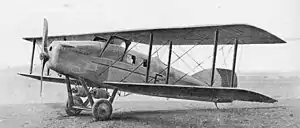Potez IX
The Potez IX was an early airliner produced in France in the 1920s, a further development of the SEA IV that Henry Potez had co-designed during the First World War.[1][2]
| Potez IX | |
|---|---|
 | |
| Role | Airliner |
| National origin | France |
| Manufacturer | Potez |
| First flight | 1920 |
| Number built | 30 |
| Developed from | SEA IV |
Design and development
The design mated an entirely new fuselage to the wing and tail structures of the earlier military aircraft.[1][2][3] This fuselage was very deep, nearly filling the interplane gap, and carried within it a fully enclosed cabin with seating for four passengers.[1][2][3] The nose area was carefully streamlined[2] with curved aluminium,[4] but other aspects of the construction were conventional for the day; wooden structures skinned in plywood (the passenger cabin) or fabric (the rest of the aircraft).[5] The pilot sat in an open cockpit aft of the cabin.[2][5]
The prototype flew in 1920,[6] and was followed by around thirty production examples that differed from it in having a larger tail fin and rudder.[2] The Compagnie générale transaérienne operated Potez IXs on cross-channel air services between Paris and London.[6] The Compagnie Franco-Roumaine de Navigation Aérienne flew these[5] on routes linking Paris to Warsaw via Strasbourg and Prague, and from Paris to Budapest via Strasbourg and Vienna, later extending its services to Bucharest and Constantinople.[6] Franco-Roumaine, and its successor airline CIDNA operated the Potez IX until 1928.[1][7]
The Potez IX S, a one-off modified version with wings of larger area,[2] flew in the Grand Prix de l'Aéro Club de France in June 1921 with Gustave Douchy at the controls.[8] Douchy was disqualified in the third stage of the competition.[8]
Specifications

Data from "The Paris Aero Show 1921" 22 December 1921, p.842
General characteristics
- Crew: One pilot
- Capacity: 4 passengers
- Length: 9.80 m (32 ft 2 in)
- Wingspan: 14.00 m (46 ft 0 in)
- Height: 3.12 m (10 ft 3 in)
- Wing area: 46.0 m2 (495 sq ft)
- Empty weight: 1,250 kg (2,750 lb)
- Gross weight: 2,050 kg (2,511 lb)
- Powerplant: 1 × Lorraine-Dietrich 12Da , 280 kW (370 hp)
Performance
- Maximum speed: 200 km/h (125 mph, 109 kn)
- Service ceiling: 6,100 m (20,000 ft)
- Rate of climb: 4.2 m/s (820 ft/min)
Notes
- Taylor 1989, p.747
- The Illustrated Encyclopedia of Aircraft, p.2760
- "The Paris Aero Show 1921" 22 December 1921, p.841
- "The Paris Aero Show 1921" 17 November 1921, p. 764
- "The Paris Aero Show 1921" 22 December 1921, p.842
- Stroud 1966, p. 176
- Stroud 1966, p. 177
- "The French Aero Club Grand Prix", p.430
References
- Coroller, Jean-Louis (September 1998). "Les premièrs avions Henry Potez (première partie)" [The First Aircraft of Henry Potez]. Avions: Toute l'aéronautique et son histoire (in French). No. 66. pp. 8–14. ISSN 1243-8650.
- "The French Aero Club Grand Prix". Flight. 23 June 1921. p. 430. Retrieved 2021-10-29.
- The Illustrated Encyclopedia of Aircraft. London: Aerospace Publishing.
- Stroud, John (1966). European Transport Aircraft since 1910. London: Putnam.
- "The Paris Aero Show 1921". Flight. 17 November 1921. pp. 758–765. Retrieved 2021-10-29.
- "The Paris Aero Show 1921". Flight. 22 December 1921. pp. 839–842. Retrieved 2021-10-29.
- Taylor, Michael J. H. (1989). Jane's Encyclopedia of Aviation. London: Studio Editions. ISBN 0-7106-0710-5.
- Warner, Edward P. (May 2008). "Les avions de ligne au banc d'essai en 1921" [Airlines on the Test Bench in 1921]. Le Fana de l'Aviation (in French) (462): 44–55. ISSN 0757-4169.